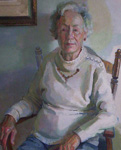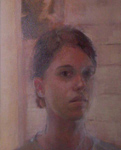 Stacey is just kickin' back. She has her hair pulled up with a red and white bandanna, and her feet are resting on a pale-blue footstool. The calmness in her face and smooth tonal transitions in her skin initially stand in contrast with the house party of color in the afghan draped behind her wooden chair.
Stacey is just kickin' back. She has her hair pulled up with a red and white bandanna, and her feet are resting on a pale-blue footstool. The calmness in her face and smooth tonal transitions in her skin initially stand in contrast with the house party of color in the afghan draped behind her wooden chair.
Stacey is an oil painting, and it's difficult to resist her when you enter the Mode Gallery to see the current show (running through July 7) featuring paintings by Katie Musolff. The exhibit is sparse compared to the number of pieces in previous Mode shows, but it's sensibly populated, with roughly a dozen larger pieces, to allow these vital works room to breathe. The show displays Musolff's uncanny ability to capture the moods of environments and the personalities of people, without losing either in her dynamic use of color.
One of the first things that strikes you when you look at Stacey is the artist's playful and bold placement of background colors and textures contrasted with the finely honed tonal sensibilities that permeate her figures.
The explosive greens, vermilions, and oranges of the afghan thrust forward the head and upper torso of "Stacey." The broad-striped pattern of the floor pushes the whole figure back in space, while the floor's cooler tones add extra punch to the pink cushion on the chair under the woman. Meanwhile, she stares forward with a nonchalant grace surrounded by these dancing, wild bursts of color.
A way of achieving variety and broadening the taste and texture palette of a soup or broth is to sauté some of your chopped carrots, onion, celery, and peppers early on to form the base of the broth, and then much later in the cooking process to add in the same ingredients again. The original vegetables soften and develop a robust, unified undertone, and the second wave brings firmer textures and brighter, crisper, and more varied flavors. This technique to expand and unify the flavors is similar to how Musolff approaches her color "ingredients."
A long look at the figure in the foreground and the afghan in the background reveals that both are brimming with exciting and unexpected pops, splotches, and swaths of color and texture. However, while they share many of the same colors, or "ingredients," Musolff aggressively pushes the background colors toward becoming a hyperkinetic fireworks display - similar to the late additions to the soup that retain some of their distinct qualities - and wisely pulls and blends the colors within the figure to a more restrained gentle flow of tones - like the initial base-forming ingredients.
The colors are not disparate; they are just subtly handled in a way that allows them to bring different contributions to the visual soup. This duality of color personalities between Musolff's figures and their environments allows them to inhabit a world that is rooted in quotidian familiarity with fantasy-like incursions of color.
Jenny Marie takes this interplay of color personalities one step further by wrapping the figure in a dazzling chromatic pantheon. In Jenny Marie, we see a black woman sitting on a blanket on the floor with a contemplative and slightly weary look on her face. Her shoulders rest against a stuffed loveseat with her elbows cocked back on top of the cushion, which is covered with a tight diamond pattern of purples and dingy oranges. The brightly colored and open kimono she is wearing is choked with fuchsias, turquoises, purples, and reds, and it flows off her shoulders and spills onto the blanket on the floor, which is dotted with rhythmic splotches of dull red.
This level of activity in the background would normally distract attention from the person, but Musolff wisely subdues the forces in the loveseat and the blanket by wrapping the figure in a wildly colored kimono, which echoes a similar array of tones in the figure.
 Because Musolff cultivates such a compelling dialogue with her usage of color, it is interesting to see the pieces in which she has established a dialogue between the "models." Each of her works captures a unique element of the model's temperament, but in Rosemary & Marge, Musolff expresses not only their individual personalities but the personality of their friendship.
Because Musolff cultivates such a compelling dialogue with her usage of color, it is interesting to see the pieces in which she has established a dialogue between the "models." Each of her works captures a unique element of the model's temperament, but in Rosemary & Marge, Musolff expresses not only their individual personalities but the personality of their friendship.
We see two older women sitting on a strangely familiar diamond-patterned couch with a mint-green cover over the cushions. The women - both in brightly patterned tops and monochromatic slacks - are sitting in the kind of enjoyable silence that only old friends can share.
The personality contrast shows up in the playful banter between the two blouses and speaks to their personal interaction as well. Their quiet yet slightly mischievous demeanor reminded me - in a fun and nostalgic way - of two gentlemen from the late 1980s who used to peddle wine coolers and thank me for my support.
 A missed opportunity for a compelling pairing comes with Double Self-Portrait. The piece itself breathes with a different type of energy from most of the other works because of its simplified and earthy color palette. Anchored into place by the vertical and horizontal masses on the wall behind her is Musolff, who is calmly staring forward with a serene and simple beauty.
A missed opportunity for a compelling pairing comes with Double Self-Portrait. The piece itself breathes with a different type of energy from most of the other works because of its simplified and earthy color palette. Anchored into place by the vertical and horizontal masses on the wall behind her is Musolff, who is calmly staring forward with a serene and simple beauty.
The artist is lowered in the composition to accommodate a partial view of the self-portrait on the wall behind her. The portrait on the wall is veiled in near-muddy shadow and doesn't achieve its interactive and conceptual potential with the image of the artist. The wall piece is a kind of documentation of the artist's mood or attitude from sometime in the past. The ongoing portrait could therefore be a comparison. Is the artist now sadder? Happier? Healthier? More confident? By subduing the portrait from the past to shadowy masses, these questions arise but can find no answers.
Because Musolff's paintings take hours to complete, obviously there is some contrivance and staging. But the scenes seem natural, and the people feel real, with all of the unglamorous richness of wrinkles and pudginess that make us all human. Although the colors are often heightened, Musolff captures her subjects in a way viewers can relate to.










